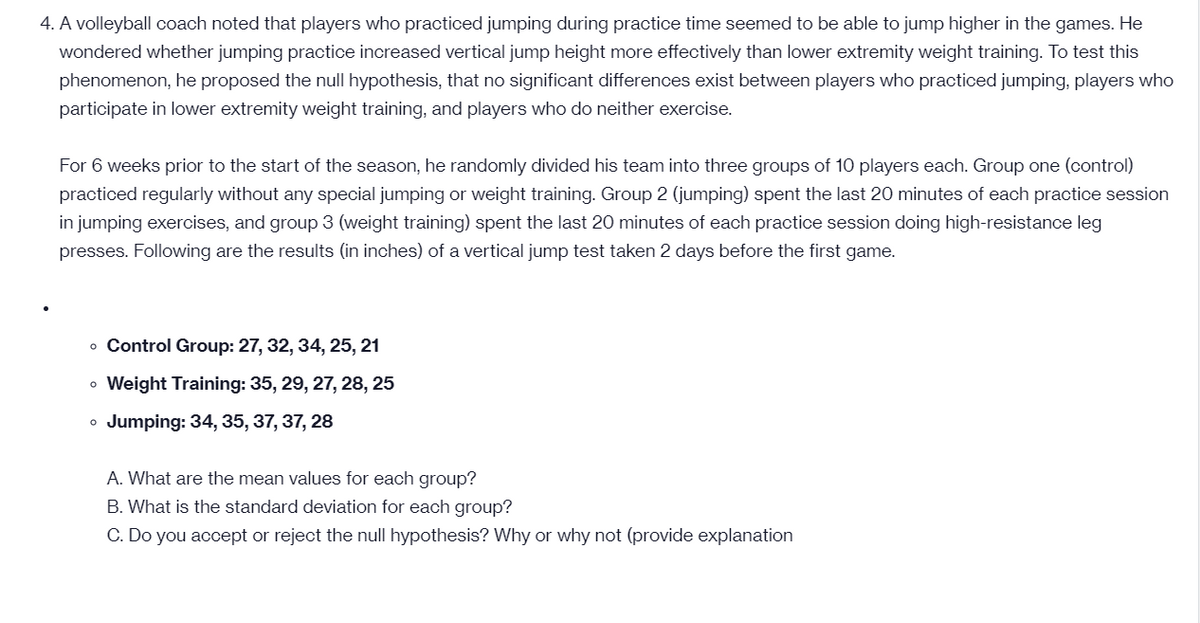• Control Group: 27, 32, 34, 25, 21 • Weight Training: 35, 29, 27, 28, 25 • Jumping: 34, 35, 37, 37, 28 A. What are the mean values for each group? B. What is the standard deviation for each group? C. Do you accept or reject the null hypothesis? Why or why not (provide explanation
• Control Group: 27, 32, 34, 25, 21 • Weight Training: 35, 29, 27, 28, 25 • Jumping: 34, 35, 37, 37, 28 A. What are the mean values for each group? B. What is the standard deviation for each group? C. Do you accept or reject the null hypothesis? Why or why not (provide explanation
Holt Mcdougal Larson Pre-algebra: Student Edition 2012
1st Edition
ISBN:9780547587776
Author:HOLT MCDOUGAL
Publisher:HOLT MCDOUGAL
Chapter11: Data Analysis And Probability
Section: Chapter Questions
Problem 8CR
Related questions
Question
solve asap the question with complete explanation within 15 mins or else downvote

Transcribed Image Text:4. A volleyball coach noted that players who practiced jumping during practice time seemed to be able to jump higher in the games. He
wondered whether jumping practice increased vertical jump height more effectively than lower extremity weight training. To test this
phenomenon, he proposed the null hypothesis, that no significant differences exist between players who practiced jumping, players who
participate in lower extremity weight training, and players who do neither exercise.
For 6 weeks prior to the start of the season, he randomly divided his team into three groups of 10 players each. Group one (control)
practiced regularly without any special jumping or weight training. Group 2 (jumping) spent the last 20 minutes of each practice session
in jumping exercises, and group 3 (weight training) spent the last 20 minutes of each practice session doing high-resistance leg
presses. Following are the results (in inches) of a vertical jump test taken 2 days before the first game.
o Control Group: 27, 32, 34, 25, 21
• Weight Training: 35, 29, 27, 28, 25
o Jumping: 34, 35, 37, 37, 28
A. What are the mean values for each group?
B. What is the standard deviation for each group?
C. Do you accept or reject the null hypothesis? Why or why not (provide explanation
Expert Solution
This question has been solved!
Explore an expertly crafted, step-by-step solution for a thorough understanding of key concepts.
Step by step
Solved in 2 steps with 2 images

Recommended textbooks for you

Holt Mcdougal Larson Pre-algebra: Student Edition…
Algebra
ISBN:
9780547587776
Author:
HOLT MCDOUGAL
Publisher:
HOLT MCDOUGAL

Holt Mcdougal Larson Pre-algebra: Student Edition…
Algebra
ISBN:
9780547587776
Author:
HOLT MCDOUGAL
Publisher:
HOLT MCDOUGAL